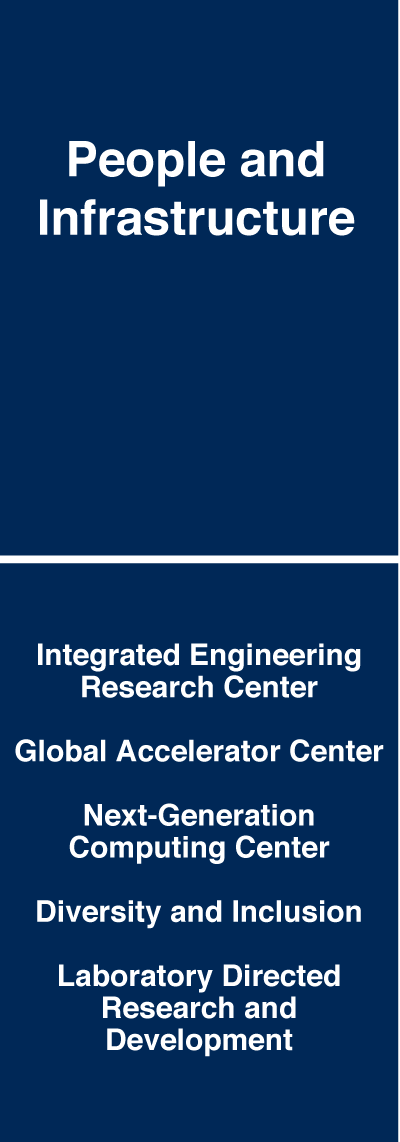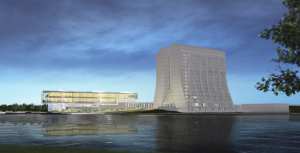Building for Science: People, Infrastructure, Innovation
Fermilab’s strategy for supporting its four core capabilities is known as “Building for Science” and incorporates building a diverse and inclusive workforce, modernizing infrastructure at all levels, and investing in the Laboratory Directed Research and Development (LDRD) program.
In the area of infrastructure, the Utilities Upgrade Project (UUP), which is 90% complete, includes replacement of the master substation and industrial cooling water piping backbone by FY 2019. This project addresses infrastructure needs for Fermilab as a large-scale user facility. The Integrated Engineering Research Center (IERC) is a major initiative that will transform the laboratory’s core capability in particle physics. Two other major initiatives, the Global Accelerator Center (GAC) and the Next Generation Computing Center (NGCC), will transform the laboratory’s core capabilities in accelerator science and technology and advanced computer science, visualization and data, respectively.The Campus Master Plan, which presents a comprehensive approach to Fermilab’s future infrastructure, has four primary objectives:
- Construct sustainable infrastructure that will attract international investment and the brightest minds to the world’s leading laboratory for accelerator-based neutrino science
- Maximize productivity by establishing an atmosphere of “eat-sleep-work to drive discovery” that efficiently meets the needs of the scientific community
- Integrate into one geographic area the entire life cycle of research, engineering, fabrication, and operations expertise for accelerators and detectors
- Consolidate, centralize, and modernize to optimize operational resources, maximize efficiency, enhance communication, and foster succession planning
These objectives address the needs of the laboratory’s core capabilities by providing facilities and infrastructure to close identified infrastructure gaps that include:
- Sufficient space for project teams and international users for the first-ever large-scale international science facility hosted by a U.S. DOE laboratory
- Buildings located closer to where the work is performed to improve efficiencies for matrixed resources supporting projects and operations
- Increased high-bay space for production facilities
- Modernized facilities with modular walls and furniture for efficient reconfiguration
- Short-term accommodations for a growing number of collaborating visitors and users
- State-of-the-art computing facilities
Integrated Engineering Research Center
A world-leading science laboratory needs world-class facilities and infrastructure to support its program. Fermilab’s campus master plan portrays a future envisioned as “a state-of-the-art particle physics laboratory that will host a vibrant, international community of employees and users on a safe, accessible site that celebrates and protects the natural environment.” The Integrated Engineering Research Center (IERC) anchors the development of the laboratory’s central campus. The IERC provides the interdisciplinary environment necessary for a world-class international neutrino science program by co-locating engineering and technical staff immediately adjacent to the main administrative building. Currently in the conceptual design phase, the project will be a new start with project engineering and design funding anticipated in FY 2017. IERC construction is expected to begin in FY 2019. The project will transform the laboratory’s core capability in particle physics by providing modernized infrastructure as well as a collaborative environment with laboratory and technical team spaces.
Global Accelerator Center
The Global Accelerator Center is envisioned as a mission-driven infrastructure improvement that will transform the laboratory’s core capability in accelerator science and technology, thus sustaining the national and international accelerator science community for many years to come. At the same time as Fermilab’s accelerator complex has transitioned from high-energy colliding beams to high-intensity proton beams for neutrino and precision science, the laboratory’s accelerator scientists and technical teams have focused more on developing transformational accelerator technologies for use across the DOE/SC complex and around the globe. These transitions, combined with the condition and age of Fermilab’s accelerator facilities, drive the need to consolidate core research functions and modernize key support facilities. The current lack of a modern, efficient, centralized space for accelerator scientists and key mission support staff reflects an infrastructure gap. A new building can bridge this gap by upgrading working conditions for more than 25% of the laboratory staff and by providing a modern work space for visiting and collaborating national and international accelerator scientists. Co-locating accelerator scientists and their technical teams will allow better integration of the accelerator science, operations, and technology functions of the laboratory and will drive future national and international advances in accelerator science and technology.
Next-Generation Computing Center
The Next-Generation Computing Center (NGCC) will transform the laboratory’s core capability in advanced computer science, visualization, and data, allowing Fermilab to keep pace with rapidly developing technologies and changing scientific demands. The NGCC will support the major initiatives that have been identified for this core capability, including HEPCloud and the Active Archive Facility. Three critical components have been identified for the NGCC. The first is big data storage. This component will provide large disk storage, tape storage, and networking and will be located underground to protect systems and data from natural disasters. The second component will provide space needed for computing systems. This will include space for scientific computing and business computing systems that will be deployed using open-air, state-of-the-art, and green cooling systems. The third component of the NGCC will provide collaboration and meeting space that is currently unavailable at Fermilab’s Feynman Computing Center. Computer scientists and their technical teams as well as collaborating scientists from around the world will benefit from the availability of small-group workspaces for collaboration, medium-sized meeting rooms, and a 300-seat auditorium. The laboratory is seeking non-DOE funding for the NGCC, and as the third major new building on the Fermilab site this building will complete the mission-driven infrastructure modernization needs identified in the Campus Master Plan.
Diversity and Inclusion
The international nature of projects that define Fermilab’s future elevates the status of the laboratory’s core organizational values of diversity and inclusion. Fermilab is committed to attracting, developing, and retaining diverse talent and cultivating an inclusive and productive work environment to support scientific, technological, and operational excellence on the part of its own staff and visiting collaborators from around the world.
To be successful, the laboratory’s culture must be conducive to continual learning, dialogue, and feedback on diversity and inclusion issues. In conjunction with the laboratory’s Diversity and Inclusion Office, the Employee Advisory Group (EAG) and an increasing number of Laboratory Resource Groups (LRGs) provide forums for dialogue and are key to identifying, prioritizing, and advancing diversity and inclusion initiatives from the ground up. Last year, Fermilab conducted inaugural sessions of implicit bias training to educate employees on the impact that subtle attitudes and behaviors have on decision-making in the workplace.
Consideration for diversity is included in every step of the recruitment process. Selection committees are diverse and members of selection committees receive training on diversity recruitment strategies and awareness of implicit bias in hiring. The recruitment website was recently updated to include an emphasis on diversity and work/life options. A jobs committee was established in FY 2016. The committee reviews all job requisitions, including the diversity recruitment plan for hiring. Quarterly reports are sent to division heads to ensure that they are accountable for increasing diversity in their divisions. In FY 2016, the laboratory launched a mentoring program to afford individuals the opportunities to develop skills and further their careers.
Laboratory Directed Research and Development
Fermilab has a LDRD program that supports discretionary research in science and technical areas that are aligned with the DOE/SC Scientific Discovery and Innovation mission and the laboratory’s strategic plan. The program maintains the scientific and technical vitality of the laboratory and supports “high-risk, high-payoff” research involving new ideas, new technical concepts, and new technology. Projects are either initiated as a targeted opportunity by the Laboratory Director or are selected via an open call for proposals. The selection committee evaluates proposals and makes recommendations to the Laboratory Director for approval.
For this fifth year of LDRD, the strategic focus again will be to solicit several small and modest scale proposals. The FY 2018 call for proposals will emphasize and encourage a broad scope of proposals with all laboratory divisions encouraged to participate. The LDRD proposals solicited during this fiscal year will be judged on, in part, the alignment of the proposed project with the laboratory’s current strategic plan.



